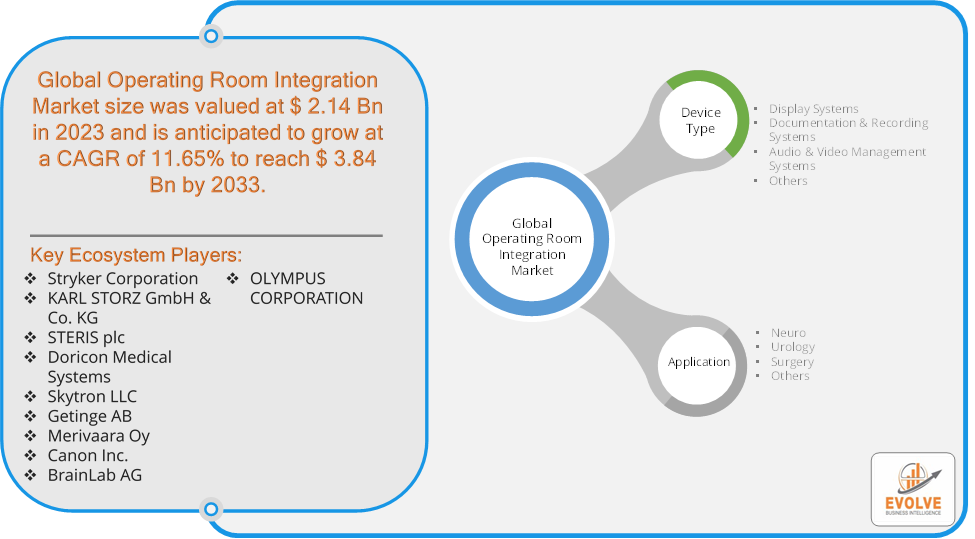Blog
Operating Room Integration Market Surges: 11.65% CAGR

Evolve Business Intelligence has published a research report on the Global Operating Room Integration Market, 2023–2033. The global Operating Room Integration market is projected to exhibit a CAGR of around 11.65%during the forecast period of 2023 to 2033.
Evolve Business Intelligence has recognized the following companies as the key players in the global Operating Room Integration Market: Stryker Corporation, KARL STORZ GmbH & Co. KG, STERIS plc, Doricon Medical Systems, Skytron LLC, Getinge AB, Merivaara Oy, Canon Inc., BrainLab AG, OLYMPUS CORPORATION.
 More Information: https://evolvebi.com/report/operating-room-integration-market-analysis/
More Information: https://evolvebi.com/report/operating-room-integration-market-analysis/
Market Highlights
The Global Operating Room Integration market is projected to be valued at USD 3.84 Billion by 2033, recording a CAGR of around 11.65% during the forecast period. The Operating Room Integration Market focuses on the integration of advanced technologies and systems within surgical environments to enhance efficiency, safety, and outcomes. It includes the incorporation of equipment such as surgical displays, camera systems, and data management solutions into a cohesive network. These systems streamline communication between devices, improve workflow management, and facilitate real-time data sharing among medical professionals. The market is driven by the increasing complexity of surgeries, the need for improved patient safety, and the growing emphasis on minimally invasive procedures.
The COVID-19 pandemic has led to supply chain disruptions leading to supply shortages or lower demand in the Operating Room Integration market. The travel restrictions and social-distancing measures have resulted in a sharp drop in consumer and business spending and this pattern is to continue for some time. The end-user trend and preferences have changed due to the pandemic and have resulted in manufacturers, developers, and service providers adopting various strategies to stabilize the company
Segmental Analysis
The global Operating Room Integration market has been segmented based on Device Type, Application
Based on Device Type, the market is segmented based on Display Systems, Documentation & Recording Systems, Audio & Video Management Systems, Others. the Audio & Video Management Systems segment generally dominates, as these systems are crucial for real-time communication, coordination, and the effective management of multimedia content during surgical procedures.
Based on Applications, the market has been divided into the Neuro, Urology, Surgery, Others. the Surgery application segment typically dominates, driven by the broad range of surgical procedures and the need for comprehensive integration solutions to enhance efficiency and outcomes in diverse surgical environments.
More Information: https://evolvebi.com/report/operating-room-integration-market-analysis/
Regional Analysis
The Operating Room Integration market is divided into five regions: North America, Europe, Asia-Pacific, South America, and the Middle East, &Africa. North America holds a dominant position in the Operating Room Integration Market. The global market is expected to be dominated by North America. As of January 2021, the National Center for Chronic Disease Prevention and Health Promotion reported that 4 out of 10 adults in the US had two or more chronic diseases, and that 6 out of 10 adults in the US had one or more chronic diseases. The total cost of these conditions to the US healthcare system is estimated to be around USD 3.8 trillion. The Asia-Pacific region has indeed emerged as the fastest-growing market for the Operating Room Integration industry. From 2023 to 2032, the operating room integration systems market in Asia-Pacific is anticipated to expand rapidly. The market is being driven by an increasing number of minimally invasive procedures, a growing number of patient populations with chronic illnesses that require surgical interventions, an increase in the demand for advanced medical devices in hospitals, and a rapidly growing healthcare infrastructure.



